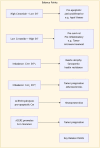Regulation of sphingolipid metabolism in the immune microenvironment of gastric cancer: current insights and future directions
- PMID: 40823076
- PMCID: PMC12350363
- DOI: 10.3389/fonc.2025.1604227
Regulation of sphingolipid metabolism in the immune microenvironment of gastric cancer: current insights and future directions
Abstract
In recent years, the role of sphingolipid metabolism in the tumor immune microenvironment has gradually gained attention, particularly in gastric cancer research. Sphingolipids are crucial components of cell membranes that regulate cell signaling and immune responses, making them important in tumor biology research. Despite numerous studies exploring the relationship between sphingolipid metabolism and gastric cancer, the specific regulatory mechanisms remain unclear. Further investigation is needed to understand their roles in the immune microenvironment. This article aims to review the regulatory mechanisms of sphingolipid metabolism in the immune microenvironment of gastric cancer, discussing its potential applications in tumor occurrence, development, and treatment. By analyzing current research progress, we will clarify the complex relationship between sphingolipid metabolism and immune cell interactions and look forward to future research directions, hoping to provide new ideas and strategies for immunotherapy in gastric cancer.
Keywords: gastric cancer; immune microenvironment; mechanistic research; regulatory role; sphingolipid metabolism.
Copyright © 2025 Hua, Zhang, Liu, Tian, Zhang, Song, Tian and Yin.
Conflict of interest statement
The authors declare that the research was conducted in the absence of any commercial or financial relationships that could be construed as a potential conflict of interest.
Figures
Similar articles
-
Interplay between tumor mutation burden and the tumor microenvironment predicts the prognosis of pan-cancer anti-PD-1/PD-L1 therapy.Front Immunol. 2025 Jul 24;16:1557461. doi: 10.3389/fimmu.2025.1557461. eCollection 2025. Front Immunol. 2025. PMID: 40777041 Free PMC article.
-
Prescription of Controlled Substances: Benefits and Risks.2025 Jul 6. In: StatPearls [Internet]. Treasure Island (FL): StatPearls Publishing; 2025 Jan–. 2025 Jul 6. In: StatPearls [Internet]. Treasure Island (FL): StatPearls Publishing; 2025 Jan–. PMID: 30726003 Free Books & Documents.
-
Signaling controversy and future therapeutical perspectives of targeting sphingolipid network in cancer immune editing and resistance to tumor necrosis factor-α immunotherapy.Cell Commun Signal. 2024 May 2;22(1):251. doi: 10.1186/s12964-024-01626-6. Cell Commun Signal. 2024. PMID: 38698424 Free PMC article. Review.
-
Single-cell RNA sequencing reveals aberrant sphingolipid metabolism in non-small cell lung cancer impacts tumor-associated macrophages and stimulates angiogenesis via macrophage inhibitory factor signaling.Thorac Cancer. 2024 May;15(14):1164-1175. doi: 10.1111/1759-7714.15283. Epub 2024 Apr 8. Thorac Cancer. 2024. PMID: 38587042 Free PMC article.
-
How lived experiences of illness trajectories, burdens of treatment, and social inequalities shape service user and caregiver participation in health and social care: a theory-informed qualitative evidence synthesis.Health Soc Care Deliv Res. 2025 Jun;13(24):1-120. doi: 10.3310/HGTQ8159. Health Soc Care Deliv Res. 2025. PMID: 40548558
References
Publication types
LinkOut - more resources
Full Text Sources





